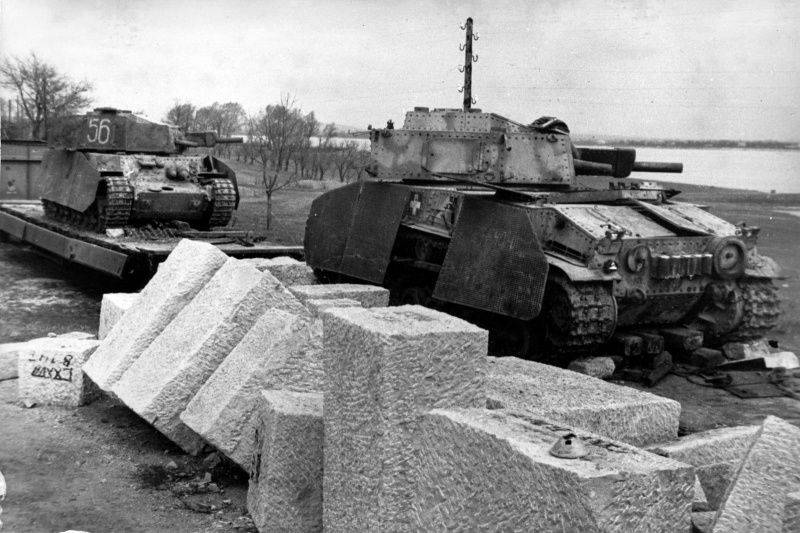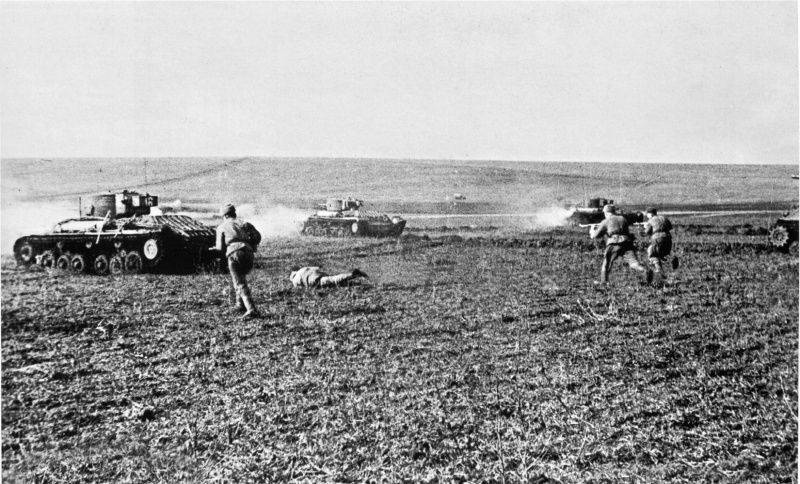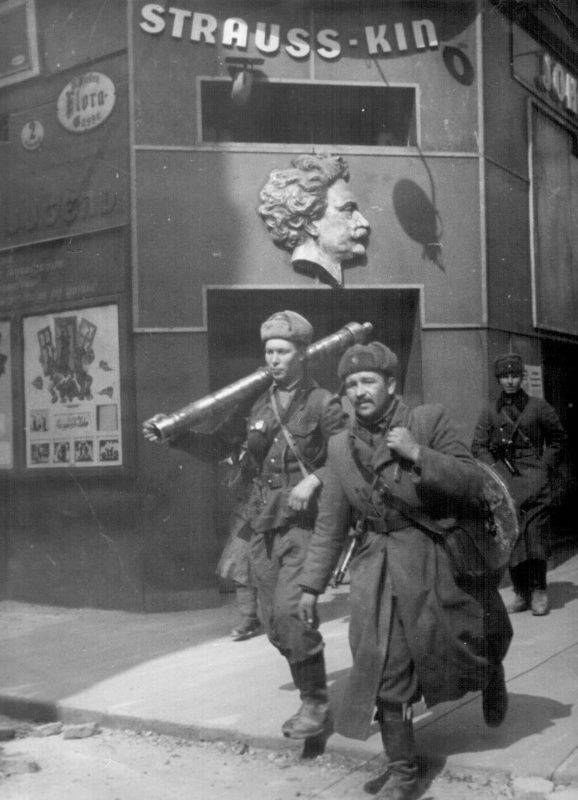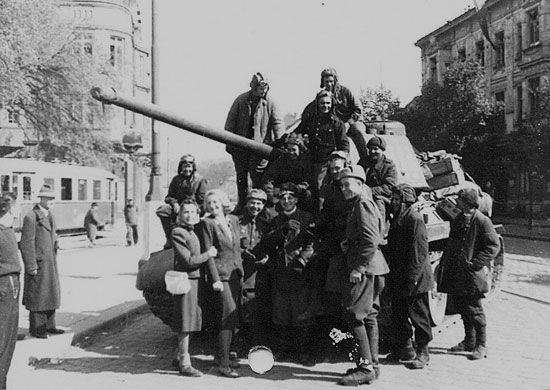Breakthrough to Austria
On March 23, 1945, the Soviet Headquarters specified the plan for further actions of the 3rd Ukrainian Front. Glagolev 9th Guards Army and 6th Guards Army tank Kravchenko’s army was supposed to attack Keseg, the 26th Hagen army - on Szombathely, the 27th Trofimenko army to occupy the Zalaegerszeg region.
The successful actions of our troops in the Vienna direction created favorable conditions for the development of the offensive north of the Danube, in Slovakia. On March 20-25, the 40th Soviet and 4th Romanian armies destroyed the last enemy bridgehead on the left bank of the Gron River and on March 26 took Banska Bistrica, a large industrial center and railway junction. March 25 began the Bratislava-Brnovsk offensive operation. The 53rd, 7th Guards, 1st Romanian armies and the 1st Guards horse-mechanized group broke through the enemy defenses on the Gron River and launched an attack on Bratislava. The Danube took part in this offensive. flotilla. On March 28, an airborne assault landing was launched in the area of Mocha, the 83rd Marine Corps brigade, which began the rout of enemy rear lines. On March 30, ships of the Danube Flotilla broke into the port of Komarno and held it until the main forces of the 7th Guards Army approached.

Two Hungarian medium tank 40M Turan (Turan II), abandoned on a railway platform near Vienna
3-th Ukrainian Front
The second stage of the Vienna operation (March 26 - April 4) is characterized by the continuous pursuit of enemy troops. The Germans covered themselves with strong rearguards and quickly retreated. Soviet aviation bombed the retreating columns of the enemy. Soviet troops were constantly advancing along field roads and highways. Advanced mobile units shot down the enemy’s barriers, and the main forces advanced in marching columns. On March 26, our troops took the cities of Papa and Devecher - large communications centers and powerful enemy strongholds that blocked the path to Austria. The Germans did not have time to gain a foothold on the intermediate lines and rolled back to the border of Austria.
The Germans equipped a strong intermediate defensive line on the River Rab. Bridges and crossings were destroyed, fords mined. On the west bank were enemy positions. This line of defense was considered practically impregnable and had to detain Soviet troops for a long time. The 6-th SS Panzer Army and part of the forces of the 6-th Field Army attempted to hold onto it. However, the Red Army did not give the enemy the opportunity to gain a foothold on this river, to recover, to gather and regroup forces, creating a new stable front. Soviet troops on the night of March 28 forced the river and did not let the enemy gain a foothold on Rab.
The actions of the platoon of junior lieutenant Sologubov are a typical example of how the Soviet units and subunits selflessly acted. The fighter Alexei Varema floated across the river and dragged along with the string, which was tied to the rope. Varema pulled the rope to the shore and secured it. As a result, the two shores were “connected”. At this time, the rest of the platoon fighters prepared all sorts of improvised boats - logs, boards, boxes, barrels, wickets, etc. Guards and foreman Guards Sergeant Pospelov with a group of specially selected fighters, the most durable and courageous, forced the river on these improvised means, using a rope, as a means of support. Machine gunner Dmitry Zakharchenny transported a heavy machine gun on a small raft. On the beach, he immediately took a comfortable firing position. So a small bridgehead was created. When the Germans discovered the enemy and went on the attack, they were met by the machine gun of Zakharchenny.
Our troops advanced 20 kilometers to the west and 28 March captured the cities of Chorna and Sarvar. April 1 was taken Sopron - a major communications hub on the way to the capital of Austria. In pursuit of the enemy, the connections of the 3 of the Ukrainian Front advanced rapidly, bypassing the resistance nodes, the German garrisons, which, fearing encirclement, fled. Movable avant-gardes in transport and reinforced with tanks seized crossings. German troops failed to gain a foothold on the third, rear line of defense, which ran along the Austro-Hungarian border. On March 29, troops of the front with a quick and powerful blow broke through the fortified strip along the border south of Sopron on the 20-kilometer stretch and broke into Austria. The liberation of Austria began.
The breakthrough of the Soviet troops across the Rab river and their advancement to the areas of Sopron, Szombathely and Zalaegerszeg led to a deep coverage of the 2 of the German Panzer Army from the northern flank. There was a threat surrounding the 2 of the German Tank Army, which was defending itself in the Nagykanizsa direction. The German command ordered the 2 tank army to immediately retreat. The Germans began to depart from Yugoslavia.
March 29 launched an offensive in the left wing of the 3 of the Ukrainian Front - the 57-I Army of Sharokhin and the 1-I of the Bulgarian Army of Stoychev. These armies attacked the 2 of the German tank army from the east and 30 in March reached the approaches to Nagykanizsa, the center of the Hungarian oil industry. At the same time, 5 units of the Gorshkov Guards Cavalry Corps attacked the German army from the north, from the Keszthely area. The Soviet cavalry made a difficult 70-kilometer march on difficult terrain, struck a sudden blow at the enemy defense and broke it. 2 April, Soviet and Bulgarian troops took Nagykanizsa. The Germans fled so quickly out of the city that they did not have time to blow up the oil producing capacity, although they had prepared them for destruction. However, in the future, the resistance of the German troops intensified, and the offensive of the left front slowed down. Meanwhile, the Yugoslav army was completing the liberation of their country.

Soviet infantry in the attack under the guise of tanks "Valentine" in the area of Vienna
One of the consequences of the breakthrough of the Soviet troops in Austria was the final collapse of the Hungarian army. The Hungarians were demoralized and did not want to fight outside their own country. For three days (March 28-30), only in the 4 th offensive zone of the Guards Army, 24 thousand Hungarians surrendered. In general, the troops of the 3 of the Ukrainian Front for the same period captured about 45 thousand Hungarians. The German command, no longer relying on the allies, began to disarm the Hungarian units. Although the remnants of the Hungarian army continued the war on the side of the Third Reich almost until the end of World War II. The ruling elite of Hungary fled to the west, capturing gold reserves and other values of the country. The Germans, leaving Hungary, also took out everything they could. According to the testimony of the Salashist dignitary from the Ministry of Agriculture Daniel Mochar, from October 1944 to April 1945, the Nazis brought 23 thousands of grain cars to Germany, up to 200 thousands of horses, about a million heads of large and up to 123 thousands of heads of small livestock.
In Austria, the resistance of the enemy intensified. The German command, in order to restore the fighting capacity of the troops and prevent incidents of panic and desertion, introduced the most draconian measures against deserters and those who disobeyed. German troops came to their senses after being defeated at Balaton and fought hard again. Almost every locality had to be taken by storm. Roads blocked the rubble of stones and logs, mined them. Bridges exploded, fords mined. On the western banks of rivers and canals, tanks and assault guns were dug down, and guns were put in direct fire. Under such conditions, the role of engineering units, which had to clear the way for infantry, tanks and artillery, restore communications, bridges and crossings, sharply increased.
The most stubborn resistance of the German troops provided in the area between the lake. Neyzidler and spurs of the Eastern Alps. A particularly powerful center of resistance on the outskirts of the Austrian capital was Wiener Neutadt, a major industrial center and communications hub. Here the Germans had several prearranged field defense lines, which were defended by the reserve infantry division, the Vienna officers' school and other units. However, the Soviet troops immediately crossed the river Leith.
The first battalion of the guard captain Kuleshov moved across the river. Junior Lieutenant Starchenko distracted the enemy from the place of the intended crossing. During the turmoil that had begun, the sappers Vinogradov and Ryazanov forced the river and made a passage in the minefield. As a result, the battalion crossed over to the other side. The Germans were taken by surprise and retreated. Bravely acted and other units. Guards senior sergeant Alexei Kuznetsov and his soldiers in two tanks bravely slipped through the canal on a German-mined bridge. Behind them the bridge was destroyed. The fighters engaged in battle with superior enemy forces. Kuznetsov said: “We will fight while we are alive!” In an unequal battle, many fell and were wounded, but the detachment survived.
The Soviet troops bypassed Wiener Neustadt from the north and, developing an offensive, intercepted the roads that connected this city with Vienna. The enemy garrison, to avoid encirclement, retreated. 3 April Soviet troops took Wiener Neustadt.
I must say that the 6-I Kravchenko Guards Tank Army, which was supposed to break away from the combined-arms armies and get ahead, could not solve this problem. This was due to the strong resistance of the enemy in rugged terrain, where there were many anti-tank obstacles, and they were easy to create. The Germans destroyed bridges, crossings, roads, created debris, mined them, and the engineering troops had to put a lot of effort into removing obstacles. Often, tankers, instead of fast-paced breakthroughs and rounds of the enemy’s resistance centers, had to destroy the centers of the German defense, losing the pace of the attack. Nevertheless, the tank army played a big role in the success of the operation, clearing the way for the infantry.
A major role in the success of the offensive, as during the first phase of the operation, was played by Soviet aircraft. She almost continuously bombed the retreating orders of the enemy, disrupted the attempts of the Germans to gain a foothold on intermediate lines. Assault and bomber aviation provided especially great assistance when the artillery lagged behind and the aircraft were the main means of supporting the advancing troops. Aviation also played a major role in the disorganization of the enemy rear, smashing railway junctions, trains, warehouses with ammunition and fuel, destroying enemy enemy manpower.
1 April 1945 The Stavka instructed the 3-th Ukrainian Front to develop the offensive with the forces of the 4-th, 9-th Guards and 6-th Guards Tank armies to develop the offensive and by the 12-15 of April to reach the Tuln-St-Pölten-Lilienfelle line. The troops of the 27, 26, 57 and 1 of the Bulgarian army to 10-12 of April were supposed to gain a foothold at the turn of the rivers Mürz, Moore and Drava. The strike force of the 2 of the Ukrainian Front was to advance in the direction of Brook-Vienna and, in cooperation with the armies of the 3 of the Ukrainian Front, take the Austrian capital. On April 3, the army of the right wing of the 3 of the Ukrainian Front reached the area of the Vienna Lowland and the long approaches to Vienna. By 4 April, the entire Hungarian territory was cleared of the Nazis.

Soviet mortar gunners carry 82-mm battalion mortar in Vienna. The fighter on the left carries a mortar barrel, and behind his back at the right is visible mortar plate
Actions shock group 2 of the Ukrainian Front
The troops of 46 Army of Petrushevsky, which were advancing south of the Danube, by the morning of March 27 1945 completed the destruction of the enemy forces, which were blocked west of Esztergom. 28 March, Soviet troops reached the Rab River and engaged in battles for crossings. Attempts by the German troops to delay the Soviet offensive in the Gyor direction were unsuccessful. Having made a detour, the troops of the 46 Army inflicted a powerful blow on the enemy in the Gyor area and continued to move rapidly in the north-west direction along the right bank of the Danube. 28 March, the army of Petrushevsky took the city of Komar and Gyor. The south bank of the Danube was cleared from the Nazis from Esztergom to the mouth of the river Rab. During the battle to free Gyor, our troops destroyed 3 Thousands of enemy soldiers captured rich trophies, including 20 warehouses with various military assets and supplies, 70 locomotives, 2 thousands of railway cars, etc. It was a big victory, which Moscow noted twenty artillery salvoes from two hundred and twenty-four guns.

Results of the second stage of the operation
The troops of 2-th and 3-th Ukrainian fronts, rapidly pursuing the enemy, moved forward on 120-170 kilometers. On some days, the pace of advance reached 25-30 km per day. Soviet troops did not allow the enemy to gain a foothold on the intermediate lines of defense, immediately broke through the third line of defense of the enemy on the Austrian-Hungarian border. Our troops completely liberated Hungary from the Nazis. Germany lost its last ally. The left wing of the 3 of the Ukrainian Front occupied the most important oil-producing region of Hungary with the city of Nagykanizsa. Soviet troops successfully invaded the eastern parts of Austria, and reached the distant approaches to Vienna.
Soviet troops were to battle for Vienna. The German command continued to strengthen the defense of Austria and actively exported industrial equipment, goods, food and valuables from the country. A real loot was subjected to a vein. The defense of the Austrian capital was given exceptional importance. Vienna was supposed to become the same fortress as Budapest and permanently detain the Red Army. Vienna was of great military-strategic importance, not only as the capital of Austria, but also the center of the Vienna industrial region, a large communications hub that connected Central Europe with the Balkans and the Mediterranean, and a major port on the Danube. Vienna during the years of Nazi rule became a major center of the military industry, monthly 850 tanks and armored vehicles got off the assembly lines of Austrian enterprises, around 1000 artillery shells, around 1,5 thousands of aircraft engines and up to 750 aircraft. Large aviation enterprises were located in the vicinity of Vienna.

To be continued ...
Information